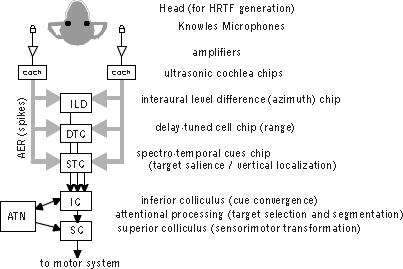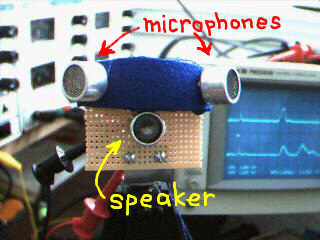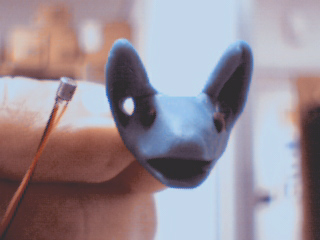 The
Plan:
The
Plan:
Goal: To construct a flying bat-sized creature that uses ultrasonic echolocation to both navigate and scrutinize its environment sufficiently to distinguish between obstacles and "insects". The bat's sensory and motor system will be constructed from neural models and implemented using "neuromorphic" VLSI techniques.
This project combines the efforts of many different members of the group, each working on various stand-alone aspects of the overall project with the goal of integrating the individual projects into a working whole. Target date is 2004.
Faculty Involvement: T.
Horiuchi, C. Moss, S. Shamma
Student Involvement: Mete
Erturk, Zhiping Shi, Kaushik Ghose
 The
Plan:
The
Plan:
Speakers
& Microphones
Ultrasonic
Cochlea
Hair cell modeling
Cochlear Nucleus
LSO and Midbrain
Inferior Colliculus
MGB and AC
Attention & Tracking
Superior Colliculus
Vocalization Control
Motor Behavior
 We are working with two different hardware systems: a physically-larger
single-frequency sonar system ("narrowband") and a tiny broadband system.
The narrowband system is being used to rapidly test concepts following
initial software tests. Photos of these two systems are found below:
We are working with two different hardware systems: a physically-larger
single-frequency sonar system ("narrowband") and a tiny broadband system.
The narrowband system is being used to rapidly test concepts following
initial software tests. Photos of these two systems are found below:
In the photo to the left, is our narrowband
sonar system that operates only on a frequency of 40 kHz. The fixed
arrangement of the microphones was chosen to produce a difference in echo
amplitude with azimuthal direction. The current system roughly extracts
direction and range and is capable of servoing the head (which is mounted
on an model airplane servo) to track moving targets in real-time.
 On
the right, we have a photo of our broadband system using a baked polymer
clay bat head with a tiny Knowles (FG3329) microphone soldered to
the end of a group of wires. This system has two broadband ultrasonic
(and audio) microphones that will feed our silicon cochleae chips.
These will be replaced with MEMS-based ultrasonic microphones in the coming
year.
On
the right, we have a photo of our broadband system using a baked polymer
clay bat head with a tiny Knowles (FG3329) microphone soldered to
the end of a group of wires. This system has two broadband ultrasonic
(and audio) microphones that will feed our silicon cochleae chips.
These will be replaced with MEMS-based ultrasonic microphones in the coming
year.
Links to useful bat webpages:
- Stephen Dear
- Nobuo Suga
- Thomas Park
- George Pollack
- Ellen Covey
- Pete Casseday
- Cindy
Moss - University of Maryland
- Jim Simmons
- Roman Kuc
- bat
detector links (a webpage in Bochum, DE)
- Ultrasound
Advice (UK) (bat detectors, ultrasonic equipment)
- Mammals
of Texas Online (eptesicus)
- Mammology
Course Homepage (University of Illinois) - bat skulls
- Bat Conservation
International